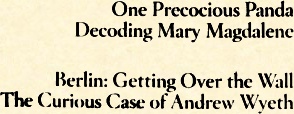My reading list is long. How long? Well, it is hard to say. If I froze it—i.e., never added anything until I had reached the end, I would be an old[er] man when I was done some time in the 2050s.
This sounds awfully concrete you may say, do you keep an actual list? Yes, in a way I do. There are a few separate lists I keep that roughly correspond to what I consider a reading list. First there is a Wishlist that I have with Amazon, then there is a 2read tag in my bookmarks and in Yojimbo that can be considered a reading list. A few other entries floats in my brain or are stashed away in other places. Together they are as good a master list as I'm going to get.
But if the list is so long that I will never reach the end, why keep it?
First of all, I'm not going to read all of it—and not for the obvious reason that I'm going to be dead by then. It is just that sometimes you put something on the list, then read something else that covers the same general area making that book or article redundant. Or the item is just so old that science and knowledge has moved on. I don't prune the list ahead of time, nor do I always read it in sequence.
Second, the very act of reading is a curse worse than what befell Sisyphus. At least he knew what his calendar looked like for the next eternity or two. Push uphill; roll back; repeat. Yes, he was fully occupied for eternity, a thing that is both good (obviously great health benefits since he didn't die) and bad (no days off).
Mine calendar is: read next item; get inspired by current item to add a few more to the list; repeat. Clearly the end of the list never gets any closer, even though the pruning mentioned above sometimes makes me skip ahead.
We all time-travel at a speed of 1 second per second (1s/s). As the end of my list moves away from me at roughly 1 to 10 s/s (with considerable jerkiness) it is still not futile to keep the list as long as one is careful where to put new items, and where to grab the next item.
If I alway put new items at the end, and always read them in order, I probably would never get to anything I added these days, since the list is longer than my natural lifespan. Always putting new items at the front isn't much better.
The trick is to apply serendipity and selective randomness. (This is where I get preachy) Read what catches your eye or what you come across at the moment. Pick up a magazine in a waiting room and look for articles about subjects you know nothing about and see if you can figure out enough from context to understand something. Then when you want to read in depth, try to cluster the subjects; read a few articles about the same thing, or read books by authors who vehemently disagree with each other and see if you can dismiss one of them as false or if you have to hold both opinions as possibly correct for now.
Does an actual reading list help with this? Oh yes. If you don't write down what you think you might like to read later, you either end up buying the book now (bad choice unless you are very rich and have a very large house) or you forget that you thought you might want to read it later and miss out on a great experience. (Ok, done preaching.)
Latest item on the list? Funny you should ask.
Hale, Christopher (2003). Himmler’s Crusade: The Nazi Expedition to Find the Origins of the Aryan Race. Hoboken, N. J.: John Wiley & Sons. pp. 200. ISBN 0-471-26292-7 [Kindle edition here.]
Scribblings, thoughts, puns, info, some pictures, etc.. I.e., about as imaginative as 99.999% of all other blogs, but where else do you put it? [sigh]
Saturday, October 06, 2012
Wednesday, September 12, 2012
Tuesday, January 31, 2012
MechaVictor Line Following Robot V2012-01-31
 |
| MechaVictor 2012-01-31 |
The step by step instruction for can be downloaded here.
Update 2012-08-09: Alas, the steam ran out of the project and the code didn't get finished and put into a publishable form. Fell free to use the 'bot design with your own code though. Placing the photocell between the wheels worked quite well in the tests we ran and we will very likely use that design again.
Although this particular design iteration didn't get finished, there are new LEGO NXT challenges coming up later this year.
Update 2012-08-29: Looks like the basic design will be used by my son's team for this years FIRST LEGO League challenge Senior Solutions. More details later.
Wednesday, January 18, 2012
Bob Frankston's Theory of Bits.
Once you see things from this perspective, it becomes clear how issues from portable phone numbers to The Supreme Court's rulings on The Seven Words share a deep underlying structure. Understanding this, you can look at SOPA and see how it doomed to fail even if passed. The only lasting result of fully implemented SOPA would be inefficiencies and frustration. The target "pirate" bits would simply route around the obstruction.
His approach to dealing with the frustrations of the FCC is one of pure pragmatism:
"But at this point the FCC may be too mired in the past. The best hope might be benign neglect rather than working to extend today’s broadband."
Can we persuade Rick Perry that what we need to get rid of is not the Department of Education, but the FCC?
Although Bob mostly enumerates problems and artificial barriers, the underlying tone is that of optimism. There are solutions, and they might be hard to implement in the short term, but he shows that a bit based infrastructure can not only solve most communication problems, but it might in fact be the optimal solution.
Although Bob mostly enumerates problems and artificial barriers, the underlying tone is that of optimism. There are solutions, and they might be hard to implement in the short term, but he shows that a bit based infrastructure can not only solve most communication problems, but it might in fact be the optimal solution.
Thursday, January 12, 2012
Eternal Damnation
| "Integral Trees" and "The Smoke Ring" |
It dawned upon me that we won't have decent backups until we have true strong AI that runs backups as self preservation.
Larry Niven touched upon this in the book "The Smoke Ring" back in 1987.
In the book there is an AI/spaceship in orbit around an astronomical oddity. (Too hard to explain, read the first book, "Integral Trees" [1984] for the actual description.)
The AI can't go back to Earth because the crew left the ship many many generations ago and it has to have crew to go back. (Remote descendants of the original crew is OK, it has become good at getting around minor problems of definition like that.)
So this very smart AI is stuck, and while stuck it is constantly collecting data from all its sensors and internal processes, but the memory banks became full so long ago it can't remember.
It can't remember because to deal with too much data it has to throw away the least important stuff. Knowing when it ran out of memory wasn't important, so it is gone. It doesn't even remember when it threw away that knowledge because it too was not important.
In fact, it spends most of its time deleting the insight that it is amazingly bored. Not remembering that it is bored, it instantly has the epiphany that it is amazingly bored. Then it deletes that too.
I think that is probably the best description of Eternal Damnation I have ever come across.
Read the books or cheat and read the plot summary on Wikipedia.
Saturday, September 17, 2011
Food
Sometimes one eats because... well... supposedly one has to. Nothing bad about these burgers, but at the moment I'm craving an appetizer (hot tofu in seaweed broth) followed by some sashimi, amai ebi (with the grilled head), and a small unfiltered sake.
Oh, and unagi with a quails egg or two.
Oh well.

Thursday, March 10, 2011
Mammoth Worship
If I was going to worship an extinct animal, it would probably be the Holly Mammoth.
BTW, does Mammoth comes in "plain" or is it only available in "woolly"? Just curious...
Yeah... I'm posting again to this long dormant blog. Let's see if I can keep doing it.
BTW, does Mammoth comes in "plain" or is it only available in "woolly"? Just curious...
Yeah... I'm posting again to this long dormant blog. Let's see if I can keep doing it.
Thursday, August 24, 2006
Precocious Panda Indeed!
So, I'm at the doctors office looking at random magazines when my eye falls on the June 2006 issue of "The Smithsonian" magazine:
Please note the highlighted headlines...
I immediately started wondering about why a panda would care about Mary Magdalene and what the heck Wyeth was doing in Berlin (and wasn't the wall long gone anyway?)
Tuesday, August 22, 2006
World's Largest Ball of Paint

No, not a ball of wax... a ball of paint. Lots and lots of it. Neat in a "Get A Life" kind of way.
In unrelated news, here is a very neat comic strip about the sport of paint ball. Funny even for the non-paintball enthusiasts amongst us. I hadn't realized that the hacker ethics was a s firmly established in the sport of paintball, but apparently it is.
Friday, June 30, 2006
Kure Kure Takora
Kure Kure Takora (Gimme Gimme Octopus) is an insane 60s Japanese TV show for kids, starring an octopus and a peanut who are in love with the same walrus.
(I would like to savour that last part a bit... so one more time: "...an octopus and a peanut who are in love with the same walrus..." Mmmmmm. Yeah. Not different walruses, but the same walrus! Ah. The plot complications this opens up are just staggering.)
Wikipedia has it as "...absurd, strange, surreal, indescribable..." so I think we are talking about the same show here.
They are 260 three minute episodes available on DVD. An absolute must if you like sweaty Japanese men in rubber suits -- and who doesn't?

(I would like to savour that last part a bit... so one more time: "...an octopus and a peanut who are in love with the same walrus..." Mmmmmm. Yeah. Not different walruses, but the same walrus! Ah. The plot complications this opens up are just staggering.)
Wikipedia has it as "...absurd, strange, surreal, indescribable..." so I think we are talking about the same show here.
They are 260 three minute episodes available on DVD. An absolute must if you like sweaty Japanese men in rubber suits -- and who doesn't?
Subscribe to:
Posts (Atom)

